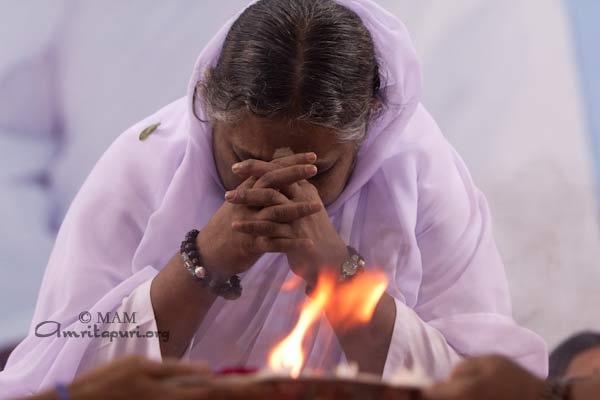The mantras chanted in Amma’s ashrams at the end of arati and archana are called shanti mantras. Therefore to conclude each one, “shanti,” which means “peace,” is chanted three times. As a spiritual aspirant, one chants shanti in desire for the occurrence of circumstances conducive to a spiritual education. But these mantras can be chanted for peace in a general sense as well. Shanti is chanted thrice not for emphasis but because disturbances are of three distinct categories. In Sanskrit, these are referred to as adhi-daivikam, adhi-bhautikam and adhyatmikam.

Adhi-daivikam literally means “mental disturbances that come from God”—i.e. things that are utterly beyond our control: hurricanes, earthquakes, volcanic eruptions, floods, tsunamis, etc. We have no control over these types of disturbances. So when we say the first shanti, we are praying, “O God, may we be protected from these obstacles that are beyond our control.”
Adhi-bhautikam literally means “disturbances that come from the world.” That means anything stemming from the world around us—mosquitoes, noisy neighbors, barking dogs, the phone ringing, family arguments. As opposed to the first category, we have some control over this second category of disturbances. We can use mosquito repellent, we can call the police on our neighbors, we can turn off the phone, we can leave the place altogether, etc. So this shanti means, “O God, may we be protected from the people and surroundings.”
The third type of disturbance is the most powerful and, at the same time, the only one over which we have total control. Adhyatmikam means “disturbances stemming from the self.” For one who is still identified with the ego, the people, places and things of this world stimulate one of two reactions in the mind—attachment or aversion. Whether we physical see someone we consider our enemy as we walk down the street or remember him during meditation, the mental turbulence that results is the same. Lust, jealousy, anger, sorrow, hatred destroy our peace. During meditation, pleasant memories also distract us. Hearing the sound of a jet plane flying overhead may mentally carry us off to a fabulous holiday we once took. Only after 10 minutes of daydreaming do we realize we have lost focus on our object of meditation.
In fact, Amma says that the ego is the only true obstacle to mental peace. This third shanti is therefore the most important one, because even if we are free from outside disturbances, if the inner realm is not calm we will never know peace. Conversely, once we have found inner peace, no external force can ever disturb us. So chanting this third shanti is akin to praying, “O God, please remove all the inner obstacles.”
There is one more element to the three-fold chanting of “shanti,” and that is the silence that follows each repetition. If chanted properly, this silence is the emphasis: shanti… shanti…. shanti….
This silence is representative of true peace, the peace of an Enlightened One like Amma. For the spiritual seeker, peace is the goal. For an Enlightened One peace has been realized as his very nature. To have be have equipoise in every situation in life verily is realization.
-Vedarat
